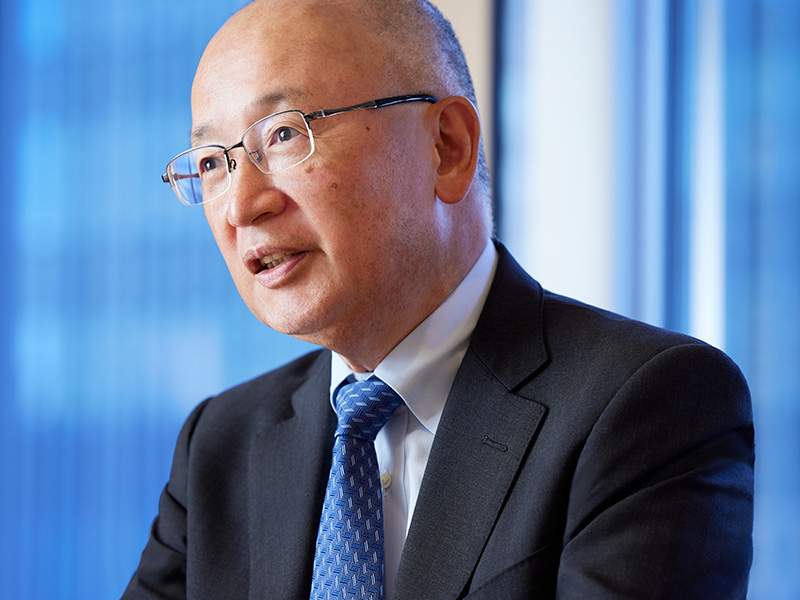- JP
- EN
Message
from the
CEO
My Mission: Achieving Growth
Together with Stable Management
in a Highly Volatile Industry

President & CEO
This message is from the MOL Report 2024.
Our Challenge

Fiscal 2023 was not an easy business environment. There were several destabilizing factors worldwide including uncertainty over the outlook for the Russia-Ukraine war and outbreak of conflict between Palestine and Israel. Fortunately, however, the shipping market remained relatively strong, and the MOL Group's corporate management plan, BLUE ACTION 2035, which we launched in April 2023, has enabled us to be even bolder than before in making future-oriented investments. Although we have outlined an ambitious growth strategy, I believe we have made tremendous progress, especially in terms of investing in new businesses and environmental measures. In addition, the measures we have implemented in our environmental and regional strategies, which represent our growth strategies, have been met with highly positive feedback from our overseas customers. I am confident that the direction we have set out in BLUE ACTION 2035 is the right one.
This was also a year in which we keenly realized the difficulty in strengthening our organization and human capital. Although we have always been aware of just how challenging a task this is, securing and developing talented personnel is vital for executing our strategy. Our regional and environmental strategies require talented personnel who understand new technologies and environmental policies, combined with the ability to link this knowledge to our business. In addition, to achieve success in our new business challenges outside Japan, it is imperative that our Japanese staff and locally-hired employees work together as a unified team. We secure the resources required for new business development through mid-career hiring, recruiting talented personnel outside Japan, collaborating with our business partners, and conducting M&A activity. Through these diverse members, we must develop human resources with strong leadership capabilities on an ongoing basis to drive the overall project forward. In summary, we are resolved to take on the difficult challenge of developing new businesses while fostering our talent base, and given the current business environment, we feel that the second year of the plan and beyond represents a critical phase for MOL to become a Resilient Global Enterprise.
Surviving and Thriving in the Competitive Global Shipping Industry
I view the medium- to long-term business environment outlook as bright. As the business environment of the shipping industry is highly influenced by market conditions, the supply-demand balance determines the prevailing situation.
Looking at the current demand environment first, despite current geopolitical risks and other uncertainties, growth in the global economy will accelerate in the future. On the supply side, in a situation in which it remains difficult to predict which alternative fuels will become mainstream in the long term to address environmental issues, it continues to be difficult to build new vessels actively. Despite this, the global demand for logistics is projected to grow at a steady, if gradual pace, and the supply of shipping capacity should eventually increase. However, the number of vessels will not simply continue to rise-vessels that have been in service for a long time will need to be scrapped progressively each year. Due to this, I believe that few factors could trigger a significant collapse in the supply-demand balance over the medium to long term. As business conditions in the past two to three years have been robust, many new containerships and LNG carriers have been ordered and are just starting to enter the market. Containership cargo volumes will grow over the long term, even if demand fluctuates from year to year due to transient factors. Given these circumstances, I expect the shipping industry to continue enjoying a relatively stable market environment.
In the past, the factors that led to failure in the shipping industry were apparent-it was the mismatch between the wave of market conditions and the investment cycle. When the global economy starts to improve, existing shipping capacity is no longer sufficient to transport the required volume of cargo, causing market rates to surge. Then, as shipping companies' cash flow grows, they begin to build new vessels. However, when these vessels are delivered, cargo volumes have tapered off, and the market has softened. This extra capacity causes a collapse in the supply-demand balance and the market slumps. When this happens, shipping companies scrap their vessels to adjust the supply-demand equilibrium, leading to a cycle of gradual restoration in the supply-demand balance.
As for the best way to navigate this environment, one effective approach is to systematically accumulate the financial strength to maintain our fleet at a certain size, to hold back on investments when market conditions and ship prices rise to extremes, and then to invest more aggressively when market conditions worsen. To develop the foundation for this approach, we are working on a Portfolio Strategy (→P.21) that allows us to maintain certain profitability even during a downturn in the shipping market. We are placing a particular focus on restructuring our business portfolio to ensure stable cash flow by diversifying our investments in non-shipping businesses, including the real property business, offshore businesses, and the cruise business.
With environmental regulations set to become stricter, new orders for conventional heavy fuel oil vessels will decrease across the industry. Instead, there will be more LNG, methanol, or ammonia-fueled vessels, which are more expensive than conventional models, due in part to the technological difficulties involved. Consequently, companies that lack the financial strength to invest on an ongoing basis will be forced out of the market, and the pool of competitors will decrease. Our policy is to decisively continue to make investments by strengthening our capital base and building financial strength when the market is buoyant while developing a portfolio via which our non-shipping businesses can support us in the event of a downturn in the shipping market. This approach will be the key that will enable us to survive and thrive in the shipping industry over the long term.
Capturing Business Opportunities On a Global Scale

As we implement our Portfolio Strategy, narrowing down the countries and regions we focus on is important since political and economic influences can change conditions at any given time. For example, Russia has rich natural gas and oil reserves and low production costs, and we were previously considering expanding our business in the country due to the high upside potential. However, given the current political conditions, it is not possible to expand at present. From a demand-side perspective, we are focusing on India as one of the most appropriate markets for the immediate future. India has an extremely high demand for energy and has historically met its energy needs through domestically produced coal. However, the country's natural gas and oil imports are projected to rise in the coming years as environmental challenges become increasingly severe. Meanwhile, on the supply side, the Middle East, which has close historical ties with India, is a potential option. I believe that demand for logistics will grow in the Global South, such as shipping to India from the Middle East or from Brazil, which has abundant resources and food supplies, and we want to focus on these countries as priority areas.
To capture business opportunities in these key economic regions in a swift manner, we will delegate authority to our regional organizations and achieve an optimal balance with top-down management. Thus far, the heads of each region and the management team at head office, including members such as our COO and CFO and I, have been constantly reviewing current developments in each region and industry sector and focusing on priority areas while maintaining a global perspective. By shifting to our current regional structure, we now have more information on the challenges that must be addressed at each location, and a better understanding of the priorities, including related timeframes. To advance to the next stage while continuing to delegate authority to each region, we will encourage the regions and head office to communicate more closely with each other to quickly identify changes in the global situation based on information gathered by the head office's management team and achieve agile decision making on priority areas.
Our Determination as a First Mover
Despite the global trend toward decarbonization, the shipping industry will remain polarized for some time as to whether or not to address environmental issues. This is because customer needs are divided between those accepting higher costs to an extent in favor of environmental friendliness and others who prioritize low-cost solutions over environmental initiatives. Amidst this trend, we must decide whether to lead the environmental initiatives or to follow from behind. As the world takes serious steps toward a decarbonized society, I believe there is a high likelihood that we will see the advent of an age in which CO2 emissions are taxed, as we are already beginning to see in some parts of the world. It is a very difficult choice, as the strategy on which we position our approach will determine our future success or failure. However, we have decided to be a first mover and to play a pioneering role in environmental investment.
From an economic perspective, if our priority were to maximize profits over a year, for example, it would be most efficient to operate inexpensive vessels that run on inexpensive fuel sources, without considering the environment. However, such a strategy would not succeed for more than a few years. In order to maximize profits five or ten years in the future, I believe the most rational approach is to optimize the business early by being the first movers in promoting environmental initiatives. As it is essential to gather information from a variety of perspectives and exchange opinions in order to implement our environmental strategy, during fiscal 2023 we participated in COP28 held in Dubai as well as the World Economic Forum.
We are now in a winner-takes-all era, where companies who move in the right direction at the right time gain momentum, while those that are late to act are left by the wayside. The IT industry is a prominent example of this. I have a strong sense of crisis that failing to adapt to changing times may put us in a position from which we are unable to recover. While responding to environmental challenges is a pressing task, we cannot afford to make errors in our judgment. To correctly process the large amount of information we have gathered and link this to correct decision-making, I think it is important that we remain committed to the COP, World Economic Forum, and other forums.
While our environmental strategy represents our basic approach, in order to implement this strategy on a global scale, we must consider each region's unique characteristics. Some regions are more focused on economic growth than the environment, while others will reject companies that lack environmental awareness, and there is also the risk of not being able to do business without taking national policies and other factors into consideration. That is why it is essential for the regional heads and the head office's management team to check regional characteristics related to environmental awareness as they conduct their business.
- Please see below for details on our participation in the 28th Conference of the Parties of the UNFCCC (COP28).
https://www.mol.co.jp/en/pr/2023/23122.html - Please see below for details on our participation in the World Economic Forum.
https://www.mol.co.jp/en/pr/2023/23088.html
Providing Social Infrastructure On a Global Scale

Our investments are progressing steadily in the non-shipping businesses, and we are making bold steps to expand our scale. However, MOL's offshore wind power generation and real property businesses are currently considered low-risk, lowreturn businesses. While there is little risk involved in operating in Japan, we cannot expect high returns from these businesses. Although we want to develop these businesses in Japan to a certain extent, going forward we will aim to leverage the human resources and expertise we have accumulated to take on high-risk, high-return projects such as real property, offshore, and logistics businesses in the growth regions of India, Brazil, and Africa, as well as offshore wind power generation businesses in countries and regions such as Taiwan. We have already launched real estate investments in India and an offshore wind power generation business in Taiwan, and our medium- to long-term goal is to accelerate our expansion further and establish a business model that generates comparatively high returns.
The MOL Group Vision outlines our goal of developing social infrastructure businesses centered around our shipping businesses. When we defined MOL as "a company that operates social infrastructure businesses," we aimed to expand our scope as a service provider beyond shipping to provide infrastructure that benefits society and people while maintaining a focus on our core shipping businesses. Outside Japan, in particular, we aspire to expand beyond shipping to grow our real property, power generation, offshore, and other businesses as social infrastructure.
A Management Phase in which We Demonstrate Our Commitment to Future Growth
Today, companies must operate their businesses with a firm awareness of the cost of capital and stock price, which is a key priority for MOL's management. In the past, business performance in the shipping industry has fluctuated dramatically, so I suspect many people look at our current position and may be skeptical about whether our strong results will continue. In BLUE ACTION 2035, we aim to maintain our target ROE at 9%‒10% in the future and to gradually increase profit before tax to ¥400.0 billion by fiscal 2035, the final year of the plan. In particular, over the coming two to three years, we are determined to continue delivering strong financial results to win the trust of our stakeholders and dispel this past image. At the same time, we are aware of the need to increase the quality and quantity of the information we disclose and for high management transparency, so that our stakeholders can better understand what is currently happening at MOL. By sustaining these initiatives, we aim to bring our P/B ratio back above 1 and enter a new management phase in which we can capture future growth opportunities to deliver a P/B ratio of 1 or higher.
We are also working to deliver shareholder returns by making proactive investment plans for the future. In line with this focus, we have set a dividend payout ratio of 30% and a minimum dividend of ¥150 per share during Phase 1 of BLUE ACTION 2035 (fiscal 2023~fiscal 2025). This is a situation in which we ask our shareholders to understand our 30% return policy for the near future. Our top priority is to achieve the objectives set in Phase 1, and we are devoting our full efforts. Once this goal is in sight, we intend to reset the minimum dividend and increase shareholder returns in Phase 2 (fiscal 2026-fiscal 2030).
A Management Approach that Ensures Stable, Continuous Growth in a Volatile Industry

MOL's business has been highly volatile in the past, particularly in terms of financial performance, and investors might have the impression that MOL is a high-risk, high-return company. Due to the nature of the shipping industry, investments take a long time to pay off. For example, investments made today may take three or five years to deliver results, meaning that the business must be managed with a medium- to long-term outlook. For this reason, we aim to transform our business into one capable of achieving stable, continuous growth through the strategies we are currently working to implement.
In the current era, referred to as "stakeholder capitalism," the most important role of management is to build stable, long-term relationships with all stakeholders, including shareholders, customers, business partners, employees, and local communities. To achieve this stable management style, we have stated that "we want MOL to be viewed as an excellent company in every aspect." Going forward, we will continue striving to be a corporate group that is valued and trusted by all stakeholders in all regards, including our response to sustainability challenges, improvement of our service quality, profitability, human resources, technological capabilities, and employee engagement.
We ask for your continued support for the MOL Group as we work to become a company that is trusted by society over the long term.




